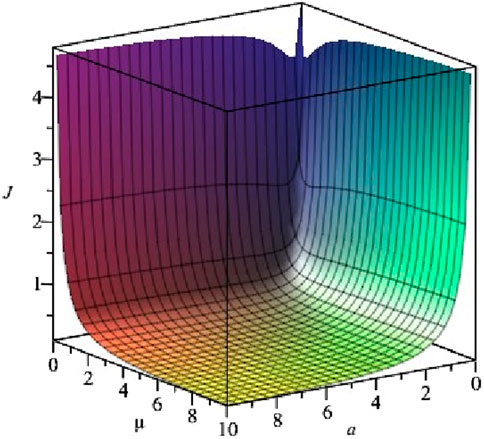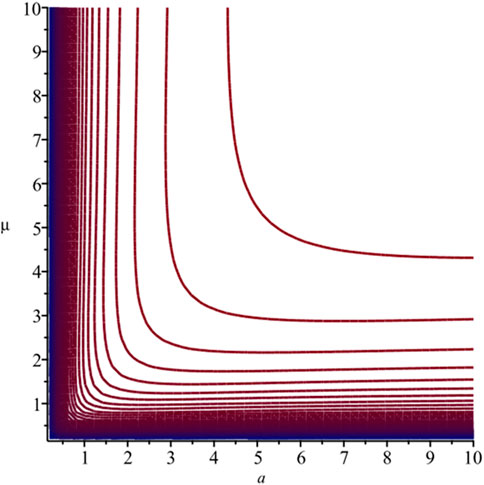- 1Department of Mathematics, University of Manchester, Manchester, United Kingdom
- 2Department Mathematics and Computer, Cheikh Anta Diop University of Dakar, Dakar, Senegal
Jitter in Internet Protocol (IP) networks refers to the variation in packet arrival times, which can cause delays or disruptions in real-time communications like voice or video calls. Managing jitter is crucial for applications requiring consistent data flow, such as voice over internet protocol, online gaming, and video conferencing, to maintain quality and reliability. Dahmouni et al. derived an analytical model for jitter in an important paper cited by many authors. But some of the fundamental equations in Dahmouni et al. do not appear correct. We correct the equations and study some analytical properties of jitter. Among others, we show that jitter can be expressed as
1 Introduction
According to Dahmouni et al. (2012a), “IP network planning and design is mostly based on the average delay or loss constraints which can often be easily calculated. Jitter, on the other hand, is much more difficult to evaluate, but it is particularly important to manage the QoS of realtime and interactive services such as VoIP and streaming video”. Dahmouni et al. (2012a) derived an important analytical model for jitter. Their results have been so important that their paper has been cited by many authors, see, for example, (Ye et al., 2023; Masli et al., 2022; Chang et al., 2024; Dbira et al., 2016; Dahmouni et al., 2012b; Sreedevi and Rama Rao, 2020; El Amri and Meddeb, 2021; Gore et al., 2022; Husen et al., 2021; Mustapha et al., 2020).
However, some of the fundamental equations (see Equations 8–11 of Dahmouni et al. (2012a)) derived in Dahmouni et al. (2012a) do not appear correct. The aim of this letter is to correct the equations. In the process, we derive an exact expression for jitter when the service times, transit times and inter-arrival times are exponentially distributed (Section 2). We also study some analytical properties of the expression (Section 2). The correctness of our derivation is verified by a Maple code given in Section 3. Some conclusions are provided in Section 4.
2 Analytical derivation
Let
Equations 9–11 of Dahmouni et al. (2012a) derive an expression for Equation 1 when
From these, we can compute Equation 7 and get.
from which we get …”. The expression given by Equations 2–4 reduces to
Proposition 1 in Dahmouni et al. (2012a) supposes that
The reminder of this section gives an exact expression for Equation 1 and studies its analytical properties when
say. Some simple calculations show that
and
Substituting Equations 6–10 into Equation 5 and simplifying, we obtain
If
Some properties of Equation 11 are
and
Let
Note that
and
The partial derivatives of Equation 12 with respect to
and
Moreover,
Setting (Equation 13) to zero, we obtain
Plots of the jitter in Equation 12 versus

Figure 1. Plot of Equation 12 versus

Figure 2. Contours of Equation 12 versus
3 Derivation using maple
The execution of the following code in Maple gives the same answer as in Equation 11.
assume(mu>0);
assume(lambda>0);
assume(eta>0);
t1:=int(mu*exp(-mu*s)*abs(s-y)*exp(-eta*y), s = 0 … infinity);
tt1:=int(t1*lambda*exp(-lambda*y), y = 0 … infinity);
t2:=int(abs(s-x)*eta*exp(-eta*x), x = 0 … y);
t3:=int(mu*exp(-mu*s)*t2, s = 0 … infinity);
t4:=int(lambda*exp(-lambda*y)*t3, y = 0 … infinity);
final:=simplify(t4+tt1);
4 Conclusion
We have derived an exact expression for jitter when the service times, transit times and inter-arrival times are exponentially distributed. The correctness of this expression has been checked by a Maple code.
Data availability statement
The original contributions presented in the study are included in the article/supplementary material, further inquiries can be directed to the corresponding author.
Author contributions
SN: Writing – review and editing, Writing – original draft. AB: Writing – original draft, Writing – review and editing.
Funding
The author(s) declare that no financial support was received for the research and/or publication of this article.
Acknowledgments
Both authors would like to thank the referee and the editor for careful reading and comments which greatly improved the paper.
Conflict of interest
The authors declare that the research was conducted in the absence of any commercial or financial relationships that could be construed as a potential conflict of interest.
Generative AI statement
The author(s) declare that no Generative AI was used in the creation of this manuscript.
Publisher’s note
All claims expressed in this article are solely those of the authors and do not necessarily represent those of their affiliated organizations, or those of the publisher, the editors and the reviewers. Any product that may be evaluated in this article, or claim that may be made by its manufacturer, is not guaranteed or endorsed by the publisher.
References
Chang, S., Wu, S., Huang, N., Zhang, Y. Y., Zhu, Y. J., Wang, C., et al. (2024). Delay jitter analysis for VLC under indoor industrial internet of things scenarios. IEEE Photonics J. 16, 1–15. doi:10.1109/jphot.2024.3456115
Dahmouni, H., Girard, A., Ouzineb, M., and Sanso, B. (2012b). The impact of jitter on traffic flow optimization in communication networks. IEEE Trans. Netw. Serv. Manag. 9, 279–292. doi:10.1109/tnsm.2012.051712.110148
Dahmouni, H., Girard, A., and Sanso, B. (2012a). An analytical model for jitter in IP networks. Ann. Telecommun. 67, 81–90. doi:10.1007/s12243-011-0254-y
Dbira, H., Girard, A., and Sanso, B. (2016). Calculation of packet jitter for non-poisson traffic. Ann. Telecommun. 71, 223–237. doi:10.1007/s12243-016-0492-0
El Amri, A., and Meddeb, A. (2021). Optimal server selection for competitive service providers in network virtualization context. Telecommun. Syst. 77, 451–467. doi:10.1007/s11235-021-00764-3
Gore, R. N., Lisova, E., Åkerberg, J., and Bjorkman, M. (2022). Network calculus approach for packet delay variation analysis of multi-hop wired networks. Appl. Sci. 12, 11207. article id 11207. doi:10.3390/app122111207
Husen, A., Chaudary, M. H., Ahmad, F., Alam, M. I., Sohail, A., and Asif, M. (2021). Improving scheduling performance in congested networks. PeerJ Comput. Sci. 7, e754. article id e754. doi:10.7717/peerj-cs.754
Masli, A. A., Ahmed, F. Y. H., and Mansoor, A. M. (2022). QoS-Aware scheduling algorithm enabling video services in LTE networks. Computers 11, 77. article id 77. doi:10.3390/computers11050077
Mustapha, O. Z., Hu, Y. F., Sheriff, R., Abd-Alhameed, R. A., and Ali, M. (2020). Evaluation of bandwidth resource allocation using dynamic LSP and LDP in MPLS for wireless networks. Int. J. Comput. Digital Syst. 9, 147–158.
Sreedevi, A. G., and Rama Rao, T. (2020). SINR based association algorithm for indoor device-to-device communication networks. Peer-to-Peer Netw. Appl. 13, 1921–1930. doi:10.1007/s12083-020-00951-0
Keywords: integration, maple, singularity, IP, jitter
Citation: Nadarajah S and Ba A (2025) On the analytical model for jitter. Front. Commun. Netw. 6:1602095. doi: 10.3389/frcmn.2025.1602095
Received: 01 April 2025; Accepted: 30 June 2025;
Published: 24 July 2025.
Edited by:
Gangwei Wang, Hebei University of Economics and Business, ChinaReviewed by:
Wuyunzhaola Borjigin, Inner Mongolia University of Finance and Economics, ChinaCopyright © 2025 Nadarajah and Ba. This is an open-access article distributed under the terms of the Creative Commons Attribution License (CC BY). The use, distribution or reproduction in other forums is permitted, provided the original author(s) and the copyright owner(s) are credited and that the original publication in this journal is cited, in accordance with accepted academic practice. No use, distribution or reproduction is permitted which does not comply with these terms.
*Correspondence: Saralees Nadarajah, bWJic3NzbjJAbWFuY2hlc3Rlci5hYy51aw==
 Saralees Nadarajah
Saralees Nadarajah Alassane Ba2
Alassane Ba2